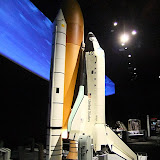 |
| National Air and Space Museum |
Within two days I and my colleagues were able to visit the National Air and Space Museum's Udvar-Hazy building, and also dip into the downtown site and the Natural History Museum next door. Entry to the Smithsonian is free and requires a bag search and sometimes a body scan, but to park out at the Udvar-Hazy costs $15 and entry is free from there.
It is easy to see why the Smithsonian is a beloved institution, due to its awe-inspiring collection. The Udvar-Hazy is described as 'America's Hangar', and so it is. As you can see in the pictures, there are planes suspended everywhere, and various levels of walkways to aid closer inspection of most of them. There are panels explaining each one, although these can sometimes be hard to find, but the sheer number, scale and experience of each one is enough to impress the beauty of engineering on its own.
Attached to the building is an air traffic control (ATC) tower, out of which you can see over to Dulles Airport and watch the planes taking off and landing. Sadly the seeing wasn't good on the day we went, but it was still a good experience to look out over the surrounding countryside. Inside there are displays about the ATC process and even a live voice feed from the main tower; what there wasn't was very much interactivity. There are simple games out there for you to try your hand at the controls, but this felt very much like a place where you go to be awed and informed, but not engaged so much. Of course, it is a museum and not a centre, and that must be made clear.
In the city centre, there is a different story. Once again there are large queues to get in, but here there is an excellent balance of the informative and the interactive, with plenty of up-to-date electronics and multi-player items. I was glad to see that Pluto had been reclassified and was told that this had happened very soon after the announcement was made in August 2006.
Both here and in the Natural History Museum however I noticed something slightly perplexing. Whilst I am not in favour of rebranding and change for the sake of it, there were several parts of the museum that were still dating from the 60s, 70s and 80s and I wondered why with all the money that must be available there was still this discrepancy. The older parts - in some cases just one explanatory panel in a sea of updated ones - really clashed with the style of the new. In some cases fonts changed as different bits were added, and it really made me question why a whole section couldn't be replaced just to bring everything into line.
The Einstein planetarium is acceptable quality, though not quite as good as I would expect for the entrance ticket of $9. We saw 'Black Holes', narrated by Liam Neeson, and only one show is a free night sky show, and that is at 10:30am three days a week.
Of course, it is difficult to sum up such an institution as the Smithsonian having only just seen a couple of its buildings in short order, but I feel it my duty to post my thoughts here for the rest of the world to see. I wholeheartedly recommend a visit should you ever be in DC, because its collection is marvellous and it has the space to show some of the most scientifically and historically important pieces around in the proper manner. An excellent visit.



No comments:
Post a Comment